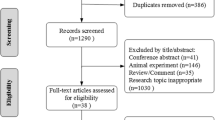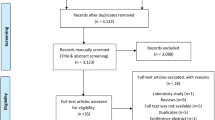Abstract
Objective
The aim of this review is to synthesize existing evidence on the combined effects of the vaginal microenvironment on pelvic dysfunctional diseases.
Methods
This systematic review was conducted in accordance with the PRISMA guidelines. The PubMed, Embase, Cochrane Library, Web of Science, Wanfang, and China Knowledge Network (CNKI) databases were systematically searched up to January 2023 using the following MeSH terms: "pelvic organ prolapse", "stress urinary incontinence" and "vaginal microenvironment", "microenvironment", "vaginal cleanliness", "vaginitis", "lactobacillus" and other related keywords. Study methods were limited to case–control studies or cross-sectional studies. Quality assessment was performed using the Newcastle–Ottawa scale, and meta-analysis of the included literature was performed using Review Manager 5.3.
Results
A total of eight articles were included in this systematic review (SR) and meta-analysis (MA), which involved a total of 7298 study participants. The pooled results of this meta-analysis showed that the vaginal microenvironment (number of vaginal lactobacilli, leukorrhea cleanliness, and presence of vaginitis) were all statistically significantly associated with pelvic dysfunctional diseases in Chinese women.
Conclusion
This review indicates that the vaginal microenvironment has an impact on the development of PFD in Chinese women.
Trial registration
The protocol of this systematic review (SR) and meta-analysis (MA) has been registered in PROSPERO databases with the Registration number of CRD42023407251




Similar content being viewed by others
References
Min J, Li B, Liu C, et al. Extracellular matrix metabolism disorder induced by mechanical strain on human parametrial ligament fibroblasts. Mol Med Rep. 2017;15(5):3278–84.
Liu C, Yang Q, Fang G, et al. Collagen metabolic disorder induced by oxidative stress in human uterosacral ligament-derived fibroblasts: a possible pathophysiological mechanism in pelvic organ prolapse. Mol Med Rep. 2016;13(4):2999–3008.
Kwon MS, Lee HK. Host and microbiome interplay shapes the vaginal microenvironment. Front Immunol. 2022;13:919728.
Borgogna JC, Shardell MD, Santori EK, et al. The vaginal metabolome and microbiota of cervical HPV-positive and HPV-negative women: a cross-sectional analysis. BJOG. 2020;127(2):182–92.
Bao YJ, Hu MC, Gao GX, et al. Multifactorial analysis of pelvic floor dysfunctional disorders. J Central South Univ (Medical Edition). 2015;40(11):1229–33.
Li T, Zhang YJ, Zhang HL, Ding XH, Yu ZJ, Lu S. Prevalence and Risk Factors of Stress Urinary Incontinence Among Perimenopausal Women and Its Influence on Daily Life in Women with Sexual Desire Problem. Curr Med Sci. 2019;39(4):615–21. https://doi.org/10.1007/s11596-019-2082-7.
Cheng C, Guo B, Li R, et al. Correlation of postpartum pelvic floor dysfunction with vaginal microecological imbalance in late pregnancy. Zhong Nan Da Xue Xue Bao Yi Xue Ban. 2022;47(11):1608–14 (Article in English and Chinese).
Li Y, Han YW, Zhang B, et al. Analysis of 1677 cases of maternal pelvic floor dysfunction screening results. Chin J Family Plan. 2022;30(05):1192–5.
Lu S, Zhang H-L, Zhang Y-J, et al. Prevalence and risk factors of urinary incontinence among perimenopausal women in Wuhan. J Huazhong Univ Sci Technol (Medical Sciences). 2016;36(05):723–6.
Huiling W. Analysis of risk factors associated with pelvic floor dysfunctional diseases in women. J PLA Preven Med. 2017;35(07):796–8.
Xiaohua W, Xiaoxu L, Kaihui X, et al. Prevalence and influencing factors of female stress urinary incontinence in selected areas of Hebei Province. J Chongqing Med Univ. 2010;35(12):1911–5.
Xu R, Wu YC, Wang WW, et al. Exploring the factors associated with pelvic floor dysfunctional disorders in women and the clinical significance of pelvic floor ultrasound in determining stress urinary incontinence SUI [J]. Modern Biomed Progress. 2022;22(01):113–7.
Guler Z, Roovers JP. Role of fibroblasts and myofibroblasts on the pathogenesis and treatment of pelvic organ prolapse. Biomolecules. 2022;12(1):94.
Ruiz-Zapata AM, Kerkhof MH, Ghazanfari S, et al. Vaginal fibroblastic cells from women with pelvic organ prolapse produce matrices with increased stiffness and collagen content. Sci Rep. 2016;6:22971.
Miao Y, Wen J, Wang L, et al. scRNA-seq reveals aging-related immune cell types and regulators in vaginal wall from elderly women with pelvic organ prolapse. Front Immunol. 2023;14:1084516.
Amabebe E, DOC A. The vaginal microenvironment: the physiologic role of lactobacilli. Front Med (Lausanne). 2018;5:181.
Jackson SR, Avery NC, Tarlton JF, et al. Changes in metabolism of collagen in genitourinary prolapse. Lancet. 1996;347(9016):1658–61.
Haque M, Singh AK, Ouseph MM, Ahmed S. Regulation of Synovial Inflammation and Tissue Destruction by Guanylate Binding Protein 5 in Synovial Fibroblasts From Patients With Rheumatoid Arthritis and Rats With Adjuvant-Induced Arthritis. Arthritis Rheumatol. 2021;73(6):943–54. https://doi.org/10.1002/art.41611.
Ni S, Li C, Xu N, et al. Follistatin-like protein 1 induction of matrix metalloproteinase 1, 3 and 13 gene expression in rheumatoid arthritis synoviocytes requires MAPK, JAK/STAT3 and NF-κB pathways. J Cell Physiol. 2018;234(1):454–63.
Huang S, Wettlaufer SH, Hogaboam C, et al. Prostaglandin E(2) inhibits collagen expression and proliferation in patient-derived normal lung fibroblasts via E prostanoid 2 receptor and cAMP signaling. Am J Physiol Lung Cell Mol Physiol. 2007;292(2):L405–13.
Zhao J, Shu B, Chen L, et al. Prostaglandin E2 inhibits collagen synthesis in dermal fibroblasts and prevents hypertrophic scar formation in vivo. Exp Dermatol. 2016;25(8):604–10.
Strinic T, Vulic M, Tomic S, et al. Matrix metalloproteinases-1, -2 expression in uterosacral ligaments from women with pelvic organ prolapse. Maturitas. 2009;64(2):132–5.
Du H, Zhang X, Zeng Y, et al. A novel phytochemical, DIM, inhibits proliferation, migration, invasion and TNF-α induced inflammatory cytokine production of synovial fibroblasts from rheumatoid arthritis patients by targeting MAPK and AKT/mTOR signal pathway. Front Immunol. 2019;10:1620.
Lin T, Ji Y, Zhao Y, et al. Expression of COX-2 and Nrf2/GPx3 in the anterior vaginal wall tissues of women with pelvic organ prolapse. Arch Gynecol Obstet. 2021;303(5):1245–53.
Jiang YJ. Effects of IL-1, PGE_2 and IL-13 on collagen expression in rabbit uterine ligament fibroblasts under microinjury. Zhengzhou University; 2012.
Macarie RD, Vadana M, Ciortan L, et al. The expression of MMP-1 and MMP-9 is up-regulated by smooth muscle cells after their cross-talk with macrophages in high glucose conditions. J Cell Mol Med. 2018;22(9):4366–76.
Lai J, Ge M, Shen S, et al. Activation of NFKB-JMJD3 signaling promotes bladder fibrosis via boosting bladder smooth muscle cell proliferation and collagen accumulation. Biochim Biophys Acta Mol Basis Dis. 2019;1865(9):2403–10.
Bhattacharyya S, Wang W, Qin W, et al. TLR4-dependent fibroblast activation drives persistent organ fibrosis in skin and lung. JCI Insight. 2018;3(13):e98850.
Luo C, Urgard E, Vooder T, et al. The role of COX-2 and Nrf2/ARE in anti-inflammation and antioxidative stress: aging and anti-aging. Med Hypotheses. 2011;77(2):174–8.
Kundu JK, Surh YJ. Nrf2-Keap1 signaling as a potential target for chemoprevention of inflammation-associated carcinogenesis. Pharm Res. 2010;27(6):999–1013.
Author information
Authors and Affiliations
Contributions
Ye Yu: project development, data collection, manuscript writing
Zhou Qin: project development
Minrong Ma: data collection
Corresponding author
Ethics declarations
Financial disclaimers
None.
Ethical approval
All analyses were based on previous published studies, thus no ethical approval and patient consent are required.
Conflicts of interest
None.
Additional information
Publisher’s note
Springer Nature remains neutral with regard to jurisdictional claims in published maps and institutional affiliations.
Rights and permissions
Springer Nature or its licensor (e.g. a society or other partner) holds exclusive rights to this article under a publishing agreement with the author(s) or other rightsholder(s); author self-archiving of the accepted manuscript version of this article is solely governed by the terms of such publishing agreement and applicable law.
About this article
Cite this article
Yu, Y., Ma, M. & Zhou, Q. The relationship between vaginal microenvironment and pelvic dysfunctional diseases in Chinese women: a systematic review and meta-analysis. Int Urogynecol J 34, 2849–2858 (2023). https://doi.org/10.1007/s00192-023-05635-w
Received:
Accepted:
Published:
Issue Date:
DOI: https://doi.org/10.1007/s00192-023-05635-w




